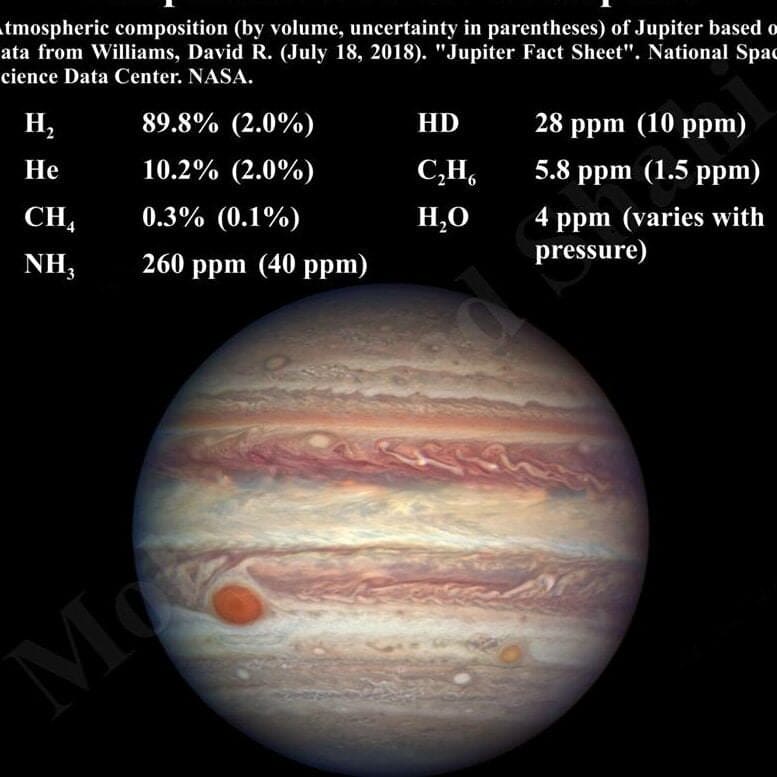Are you curious about the chemical makeup of the largest planet in our solar system? What gases make up Jupiter? Jupiter, often referred to as the planet king, is composed of unique elements and compounds that contribute to its distinctive features. We invite you to explore this article to expand your understanding of this colossal gas giant.
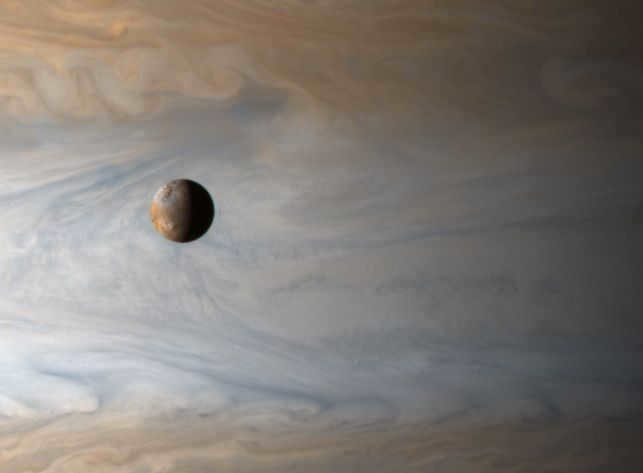
Composition of Jupiter
Jupiter is a massive planet made up of a combination of hydrogen, which makes up 93% of its composition, and helium, which makes up the remaining 7%. It is primarily composed of gases and accounts for 71% of the total mass of all the planets in the solar system. Jupiter is essentially a gas giant.
Being the fifth planet from the Sun, Jupiter follows Mercury, Venus, Earth, and Mars in the order of celestial bodies. It was named after Jupiter, the god in Roman mythology. Due to its brightness, Jupiter can be easily observed with the naked eye in the night sky. It is the fourth brightest celestial body, ranking above the Sun, Moon, and Venus.
However, the brightness ratio between planet Venus and Jupiter varies depending on the month of the year. For instance, in March, Venus outshines Jupiter, while in other months, the opposite is true.
Jupiter’s Characteristics
Similar to other gas giants, Jupiter experiences wind speeds of nearly 600 kilometers per hour in its surface layers. The planet is famous for its Great Red Spot, a pressure area in its atmosphere that showcases stunning and distinctive features, regularly observed by astronomy enthusiasts.
It has been established that Jupiter emits more energy into space than it receives from the Sun. One remarkable feature of Jupiter, for which we should be immensely thankful, is that due to its position, it has served as a protective barrier for life on Earth. Without Jupiter’s orbit and position, our planet would be at a 1,000 times higher risk of asteroid impacts.
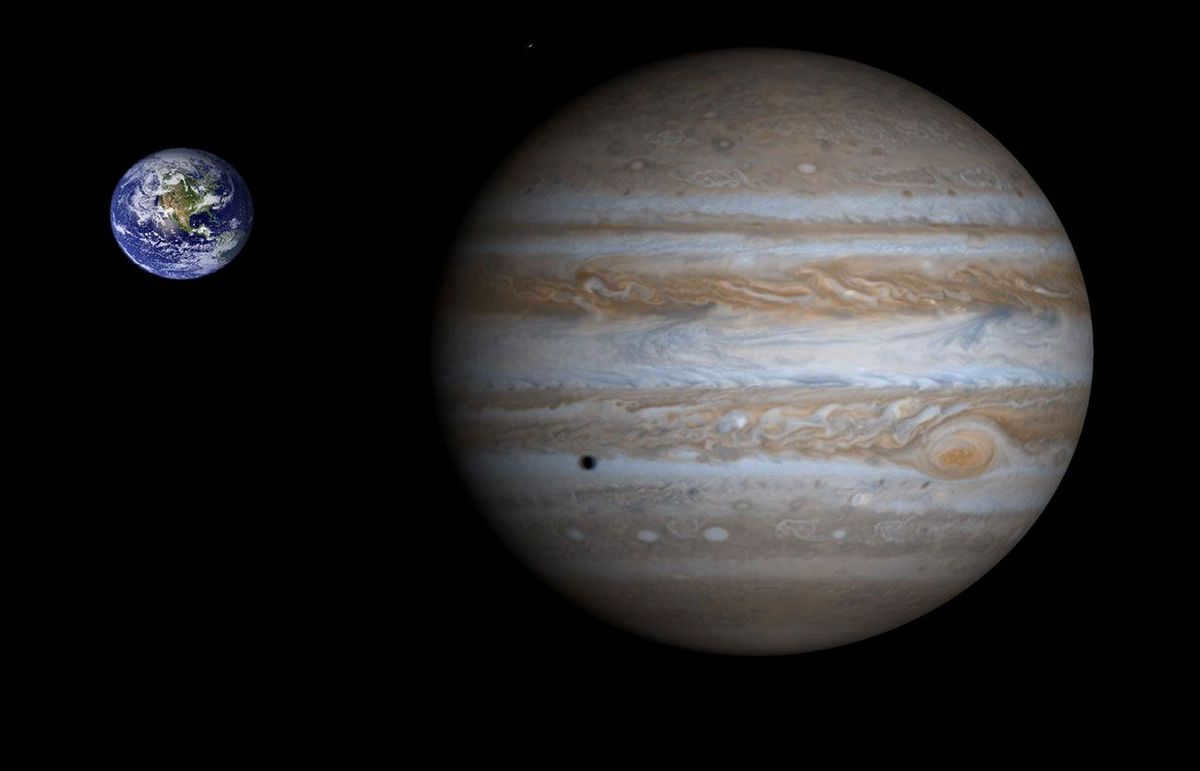
The occurrence of asteroids and meteor showers in our region of space follows a cyclical pattern, repeating approximately every 60,000 years. However, for the development of life on Earth, the presence of Jupiter has played a crucial role.
The inclusion of this massive planet within our solar system was vital, as its immense mass generates a gravitational force that attracts the largest objects that pose a significant threat of widespread devastation.
Curious about the number of Jupiter’s moons? Well, there are quite a few. To start off, this planet is surrounded by over 60 satellites. The first moons of Jupiter were spotted in 1610. Using a basic telescope, Galileo Galilei was able to identify the four largest moons of Jupiter: Io, Europa, Ganymede, and Callisto.
Later on, thanks to space explorations, we gained a more comprehensive understanding of the number of Jupiter’s satellites. During the Voyager probe’s mission in 1979, Metis, Adrastea, and Thebe were discovered. However, even before space exploration, various astronomers had already found Amalthea (1892), Himalia (1904), Elara (1905), Pasiphae (1908), Sinope (1914), Lysithea and Carme (1938), Ananke (1951), Leda (1974), Themisto (1975), and Callirrhoe (1999).
In the year 2000, Jupiter’s system saw the addition of ten new satellites, which brought the total number of Jupiter’s satellites to 28. The following year, in 2001, an additional eleven satellites joined the existing ranks. Then, in 2003, the number of known satellites increased by 23, ultimately reaching a total of 63 satellites by 2006. It is worth noting that the largest satellite has a diameter of 9 kilometers.
In 2007, when the New Horizons space explorer approached and flew over Jupiter, we had the opportunity to closely observe its atmosphere. During this exploration, we were able to identify bands of clouds that alternate in a scattered pattern. Additionally, we discovered that the giant planet experiences storms characterized by massive whirlpools that take on an oval shape.
As previously mentioned, Jupiter is an immense celestial body that acts as a protective barrier for Earth. This is due to the fact that a planet is a celestial object that orbits around a star, such as our Sun, and possesses sufficient mass to exert gravitational force and divert other cosmic entities away from its trajectory. Consequently, Jupiter has intercepted numerous masses that posed a potential threat to our planet.
Jupiter and its measurements
It has been determined that the size of Jupiter is approximately 11.2 times the size of Earth and that this celestial body completes one full rotation in 9 hours, 55 minutes, and 27.3 seconds, constituting a complete day on Jupiter. Due to its immense size, it can be inferred that Jupiter moves at an incredibly high velocity.
Now let’s examine some other key measurements pertaining to Jupiter:
- Aphelion (106 kilometers): 816.62
- Perihelion (106 kilometers): 740.52
- Eccentricity: 0.048775
- Synodic period (days): 398.88
- Average orbital velocity (km/s): 13.07
- Inclination to the ecliptic: 1.30530°
- Axial tilt: 3.13°
- Average diameter: 139,822 km
- Volume (km3): 1.43128×1015
- Mass (kg): 1.8986 x 1027, which is 317.8 times the mass of Earth.
- Rescue speed (km/s): 59.5
- Equatorial size (km): 142,984
- Polar size (km): 133,708
- Albedo: 0.52
- Number of moons: 79 currently
- Surface temperature: -121°C (152K)
- Stellar rotation period: 9 hours 55 minutes 27.3 seconds
- Composition: about 89% hydrogen, 10% helium
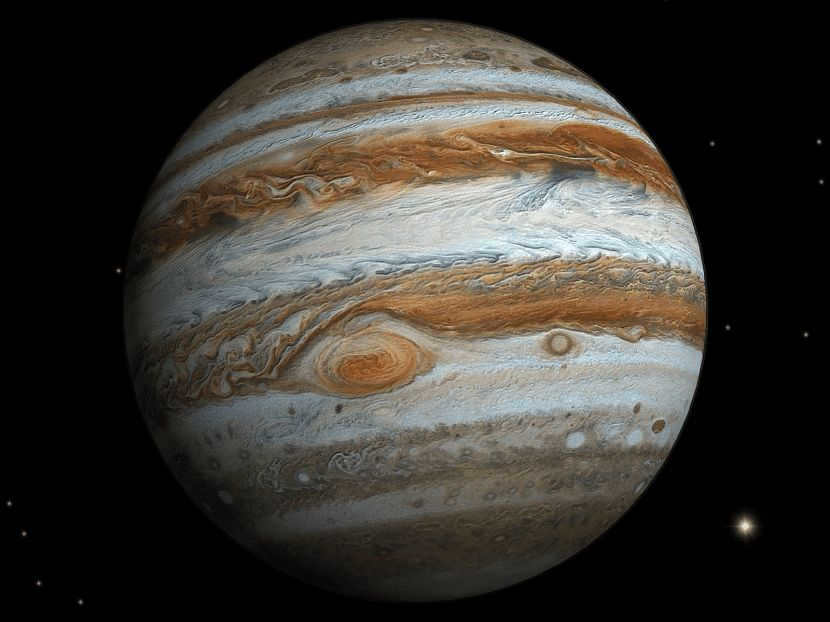
The Composition of Jupiter
The structure of the planet Jupiter has not been definitively determined. However, it is believed that these massive planets are formed from a combination of hydrogen and helium gases surrounding a core comprised of rock and ice.
Jupiter has a mass approximately 318 times that of Earth. It is hypothesized to have a rocky core, consisting of a conglomerate of iron and silicates, similar in size to Earth and estimated to be around 10 times the mass of Earth. The core is surrounded by a layer of liquid hydrogen and helium, with temperatures reaching about 16,000-80,000 degrees Kelvin and pressures of up to one million atmospheres.
Undoubtedly, researchers have extensively examined the structure of Jupiter based on proposed models. Instinctively, the core of the planet constitutes approximately 7% of its overall size, a proportion so minuscule that scientists hardly acknowledge its existence when discussing Jupiter.
While it is accurate to assume that 93% of Jupiter’s volume consists of gases, it would be misguided to liken these gases to our atmosphere. Instead, they seem to resemble a remarkably dense aqueous medium that is immensely compressed due to the gravitational force exerted by the planet.
It is hypothesized that at the core of Jupiter, the molecules of hydrogen undergo a breakdown due to the immense pressure, transforming into ionized hydrogen. During its journey towards the surface, hydrogen gradually transitions into a state of gaseous liquid, resulting in the absence of distinct boundaries between the hydrogen layers within Jupiter.
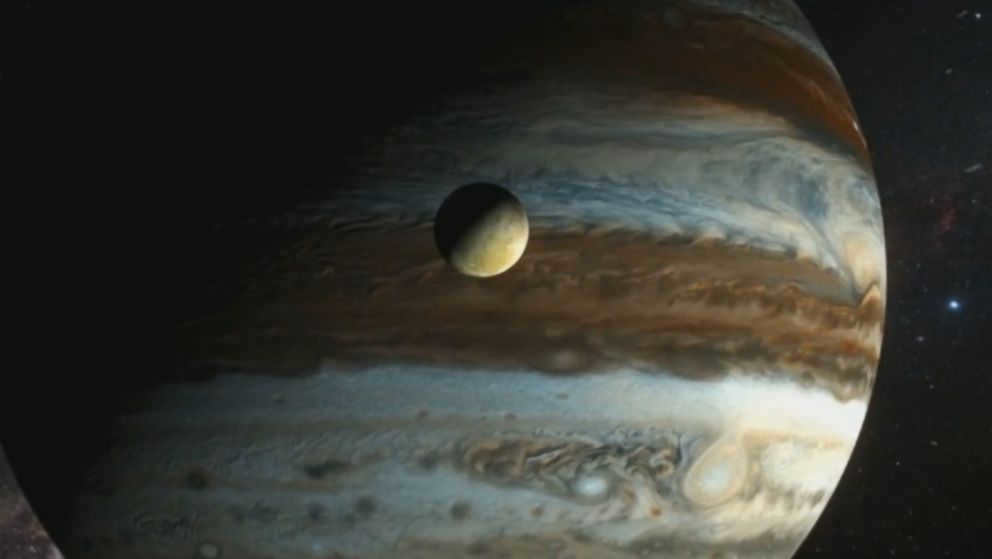
Composition and temperature
If we were to slice through Jupiter’s layers, we would observe a gradual descent into a condensed mist that becomes denser and less transparent until it reaches a lake of liquid hydrogen.
This lake would be even denser and hotter, reaching the peak of metallic hydrogen, which is significantly denser and hotter (16,000-25,000 K), before reaching a rocky core with a temperature of approximately 80,000 K and a pressure of around 100 million atmospheres.
An Enormous Crimson Mark
We have previously indicated that Jupiter, named after a deity in Roman mythology, is the most massive planet in our solar system, being approximately 317 times larger than Earth. It is visible in the night sky, particularly during the period when Jupiter and the Sun are positioned on opposite sides of the sky, as seen from our planet. This is when Jupiter is closest to Earth.
These opposing positions between the Sun and Jupiter occur every 13 months. It is during this alignment that the subtle bulging of Jupiter can be most effectively observed. An enormous crimson mark is detectable on its surface, positioned closer to its southern region, specifically at a latitude of 35°.
Although the Earth and the other planets in the terrestrial group consist of a combination of silicates and iron, with a small amount of gases surrounding them, Jupiter is primarily made up of hydrogen and a small amount of helium, making its structure very similar to that of the sun.
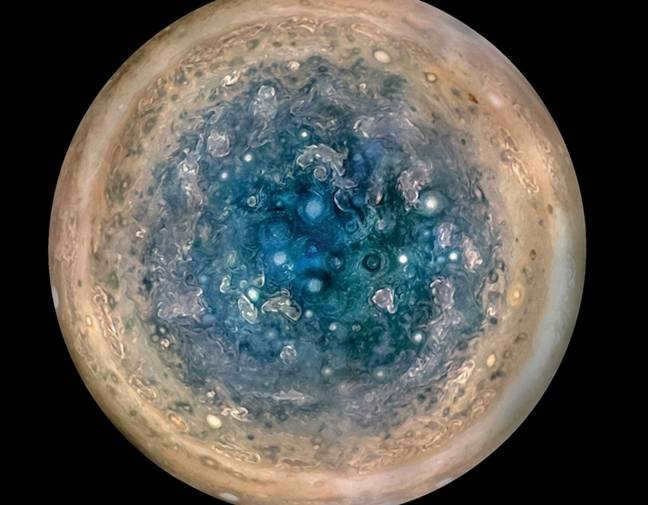
The incredible journey of the Galileo spacecraft
The Galileo spacecraft, developed by NASA, was sent on a mission to explore the majestic planet Jupiter and its fascinating satellites. In 1995, it bravely entered Jupiter’s atmosphere and within just one hour, it made groundbreaking discoveries. With wind speeds reaching an astonishing 320 kilometers per hour, Galileo was able to confirm that hydrogen is the predominant gas on Jupiter and that the temperature increases rapidly towards the planet’s core.
Furthermore, Galileo’s observations revealed that Jupiter, like other giant planets, has a remarkable ring system. This system consists of small rock fragments that orbit around a large and incredibly thin disk. In addition to the ring system, Jupiter boasts another incredible feature – the Great Red Spot. This massive cyclone, first discovered by the renowned astronomer Cassini approximately 300 years ago, continues to captivate scientists and stargazers alike.
This cyclone has dimensions of 12,000 x 25,000 kilometers, making it twice as large as Earth. In addition to its immense size, the reasons behind its long-lasting nature and continued existence remain unknown.
Research has indicated that a cyclone should undergo changes and eventually dissipate, however, when it comes to Jupiter, the Great Red Spot has shown little alteration even after 300 years of observation and study. The exact mechanism behind its formation remains a perplexing mystery to the scientific community.
For over a century, astronomers have asserted that the Great Red Spot is the largest visible structure on Jupiter. However, thanks to the images captured by the Cassini space probe, the existence of another structure of comparable size has been revealed and has been given the name the Great Dark Spot.
The Dance of Galilean Moons
During the Galileo mission conducted from 1989 to 1995, the asteroids Gaspra and Ida were thoroughly investigated, leading to the discovery of Ida’s own satellite, which was given the name Dactylus. In 1995, the Galileo mission successfully transmitted a module that was capable of descending into the atmosphere of Jupiter for a duration of 1 hour.
Unfortunately, the module was destroyed upon reaching a depth of 200 kilometers, succumbing to the immense pressures exerted by Jupiter’s atmosphere and experiencing temperatures as high as 460°C.
Nevertheless, this brief period of time allowed for the identification of the various elements comprising Jupiter’s atmosphere. A year prior, in 1994, the Galileo mission had the unique opportunity to witness the collision of Comet Shoemaker-Levy 9 with the surface of Jupiter.
The four moons of Jupiter discovered by Galileo Galilei
The four moons of Jupiter, namely Io, Europa, Ganymede, and Callisto, engage in an intricate dance that can be easily observed using basic 10×50 binoculars. With a 60 mm observation instrument, we can also witness two wide and dark bands or rings that run parallel to the planet’s equator.
Cassini’s Mission to Explore Space
When it comes to Io, scientists have discovered that it boasts the most extensive volcanic formation in our solar system, spanning over 3,600 kilometers. Surprisingly, this makes Io slightly larger than our Moon, which measures 3,474.6 kilometers.
The Cassini space probe, capturing images against the backdrop of Jupiter’s mesmerizing cloud swirls, has played a vital role in this groundbreaking discovery. Consequently, there has been considerable speculation regarding the size of this remarkable satellite.
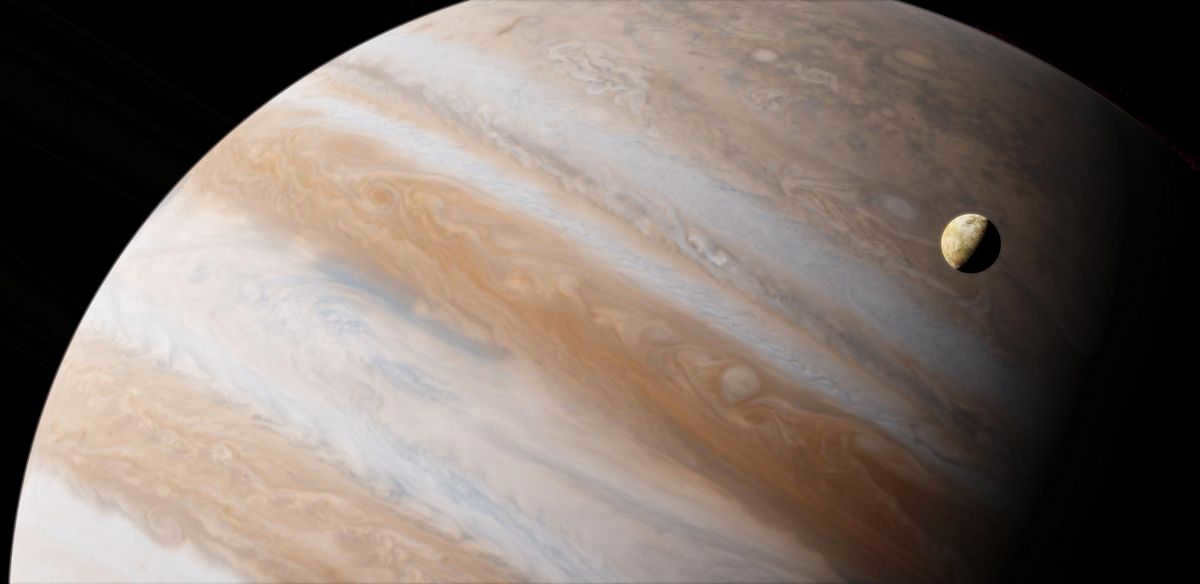
Based on data collected by the Cassini probe, it has been determined that Io is revolving around Jupiter at an incredibly high velocity, positioned approximately 350,000 kilometers above Jupiter’s cloud layer. Interestingly, this distance is comparable to the average separation between the Earth and the Moon. These findings were derived from images captured by the Cassini probe, which had a remarkable range of approximately XNUMX million kilometers from Jupiter.
Cobbler-Levy 9: A Unique Encounter with Jupiter
In 1992, during its penultimate flyby, the comet Shoemaker-Levy 9 had a close encounter with the majestic planet Jupiter. The planet’s powerful atmosphere had a profound impact on the comet, causing it to fragment into 20 pieces. However, despite this disruption, the comet remained on its determined course.
Two years later, as the comet once again approached Jupiter, a remarkable event unfolded. Fragments of Shoemaker-Levy 9 fell onto the surface of the gas giant over a period of 7 days. This extraordinary incident captivated the attention of astronomers worldwide, who eagerly observed the aftermath using various wavelengths and instruments. The impact zone became the site of a conspicuous cloud of material, a testament to the immense forces at play.
We hope you found this article insightful and that it inspires you to delve deeper into the captivating mysteries of our solar system.
Full article path: postpost “planets” Jupiter: characteristics and composition of this celestial body
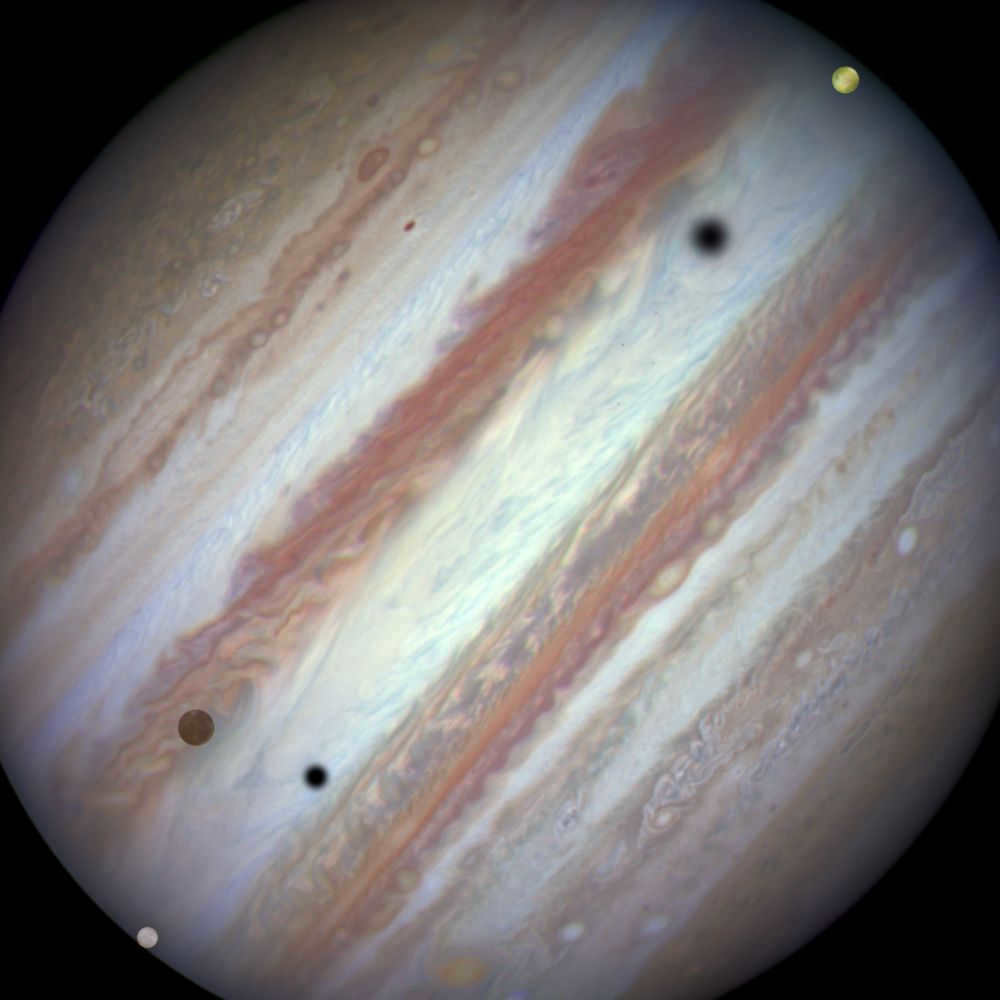
It is likely challenging to envision conditions more contrasting for a resident of Earth than those found on planets like Jupiter. While it may be possible to imagine that millions of years ago, Mars’ dusty surface could have been blanketed by forests and oceans, any resemblance between Earth and the gas giants cannot be seriously considered. These celestial bodies are incredibly difficult to study, resulting in the structure and composition of Jupiter largely remaining a mystery. Mankind is striving to uncover this mystery, relying on fragmentary knowledge acquired through extensive and painstaking research.
White horses are clouds
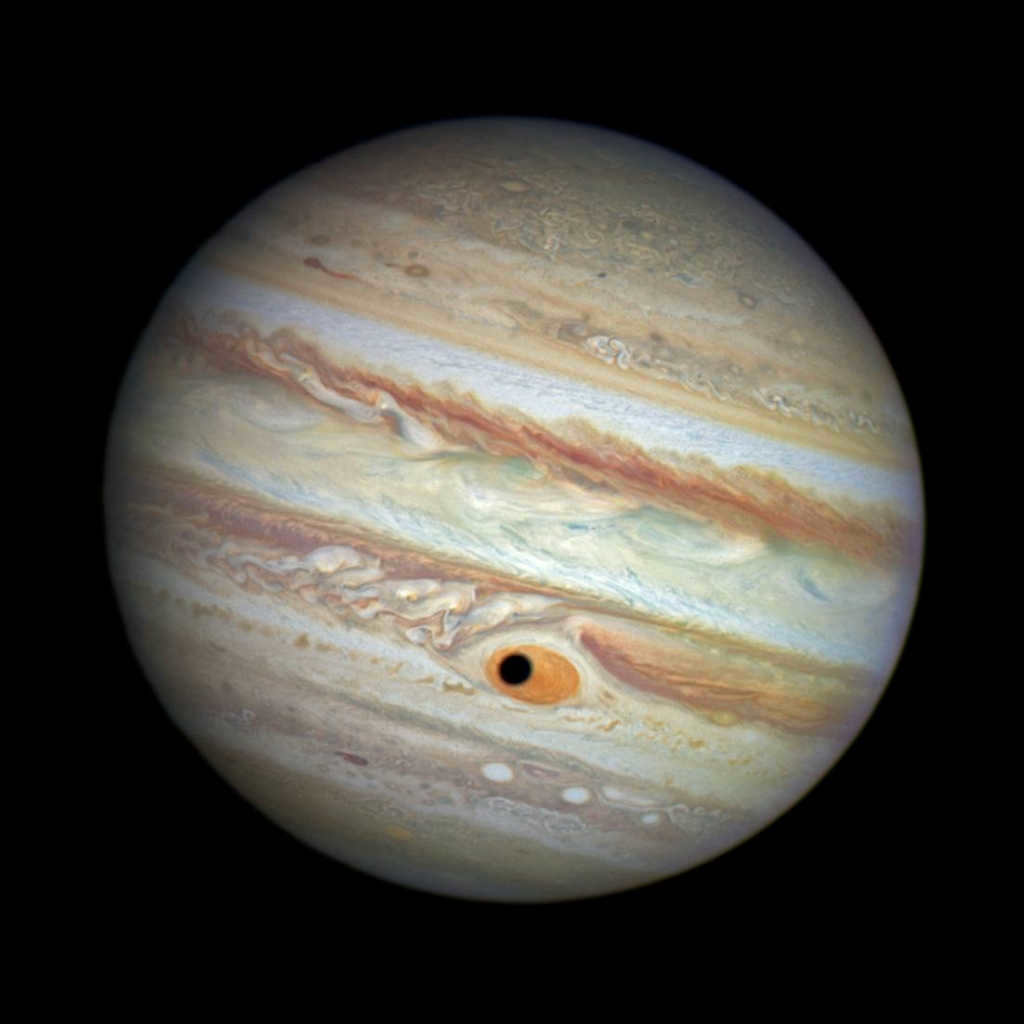

The Great Red Spot witnesses the journey of Ganymede, a satellite of Jupiter.
Atmospheric Hurricanes
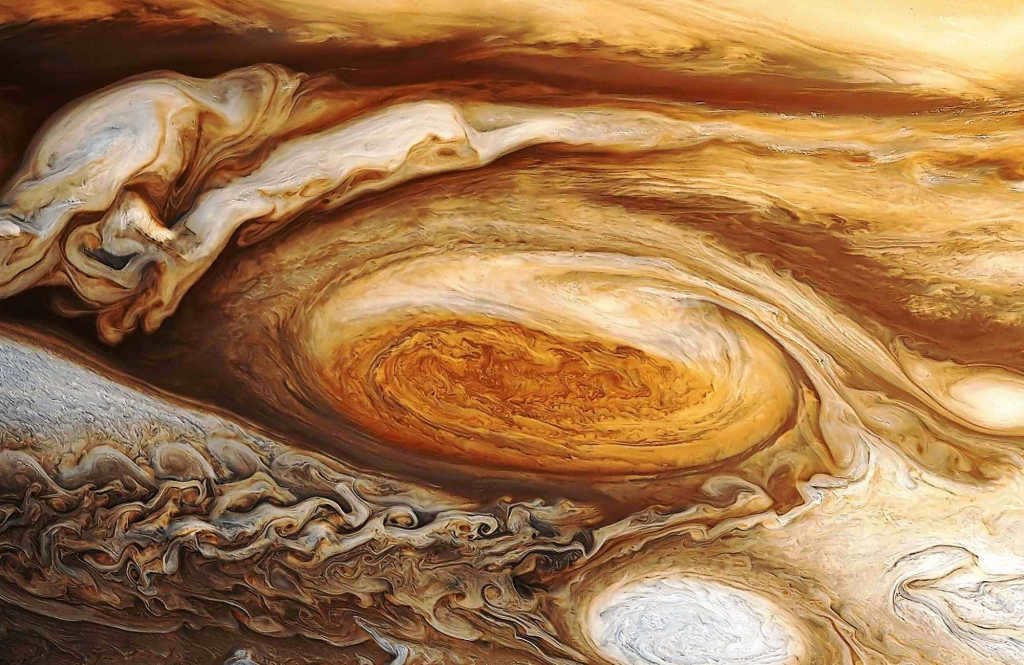

Processed image showcasing the Great Red Spot on the gas giant Jupiter
Hurricanes raging within Jupiter’s atmosphere at speeds surpassing 600 km/h, along with turbulent flows and eddies emanating from below, generate disturbances in the cloud masses, resulting in peculiar patterns in the form of stripes and spots. Unlike Earth, the movement of flows in the gas giant’s atmosphere is fueled by its internal energy, thereby resulting in the formation of patterns with relatively stable geometric dimensions that exhibit minimal changes over their observation period.
The nature of these phenomena remains inadequately understood, and currently, there is no unified theory that can fully explain the origin and long-term persistence of stripes and spots within Jupiter’s atmosphere.
Present concepts on the arrangement and makeup of Jupiter
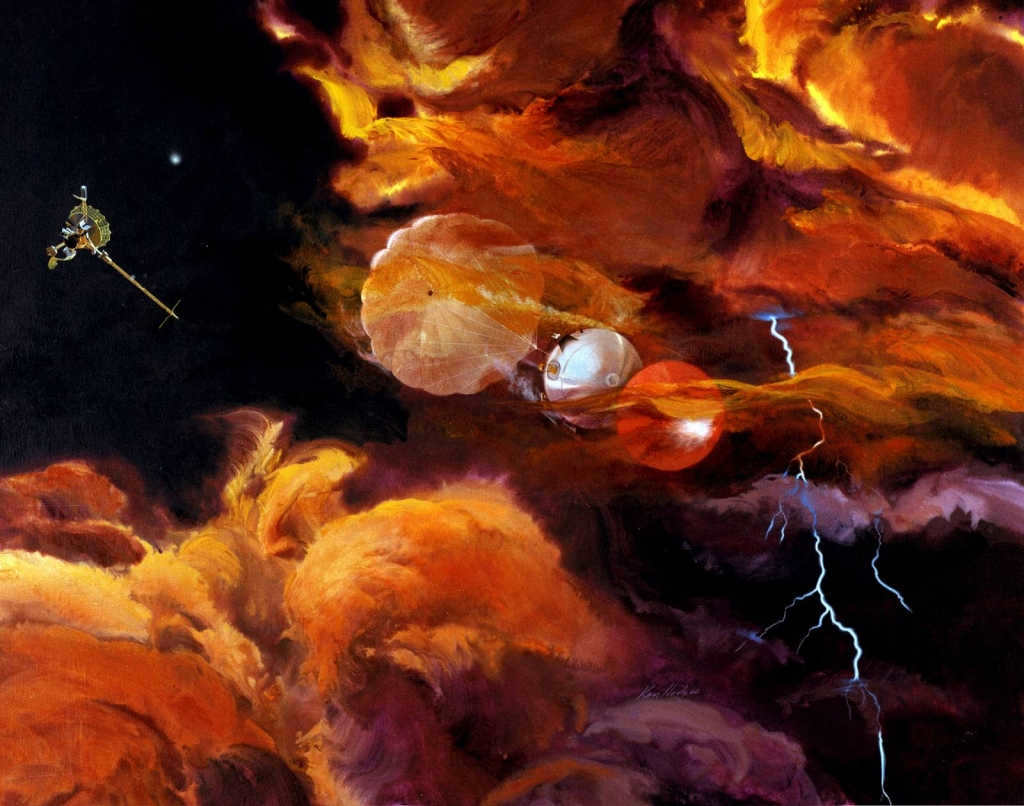
An illustration by an artist shows the Galileo probe being released into the atmosphere of Jupiter. On the right side of the drawing, the artist has depicted the removal of the probe’s protective heat shield.
Many scientists tend to believe that Jupiter, the largest planet in our solar system, is composed of an atmosphere, a core, and an intermediate layer. The primary elements found on Jupiter are hydrogen and helium. However, the findings from the Galileo spacecraft mission, which deployed a probe onto the planet in the late 1995, have confirmed the presence of argon, krypton, carbon, nitrogen, and several other gases. The outermost layer of Jupiter’s atmosphere is composed of hydrogen gas, while the middle layer contains a mixture of hydrogen and helium in a ratio of 1 to 9. The lower layer consists of ammonia, ammonium hydrosulfide, and water, which form the planet’s cloud cover.
Metallic hydrogen: a unique substance
Metallic hydrogen is a fascinating material that has captured the attention of scientists around the world. This substance is formed when hydrogen is subjected to extremely high pressures, causing it to transition from its usual gaseous state to a solid metal-like form.
One of the most intriguing properties of metallic hydrogen is its potential as a superconductor. Superconductors are materials that can conduct electricity with zero resistance, and they have a wide range of technological applications. If metallic hydrogen can be stabilized at ambient pressures, it could revolutionize fields such as energy transmission and storage.
However, creating and studying metallic hydrogen is a significant challenge. The extreme pressures required to form this substance are difficult to achieve and maintain. Additionally, metallic hydrogen is highly unstable and tends to revert back to its gaseous state once the pressure is released.
Despite these challenges, scientists remain optimistic about the potential of metallic hydrogen. They are actively working to find new methods for creating and stabilizing this unique material. If successful, metallic hydrogen could open up new possibilities in materials science and advance our understanding of the universe.
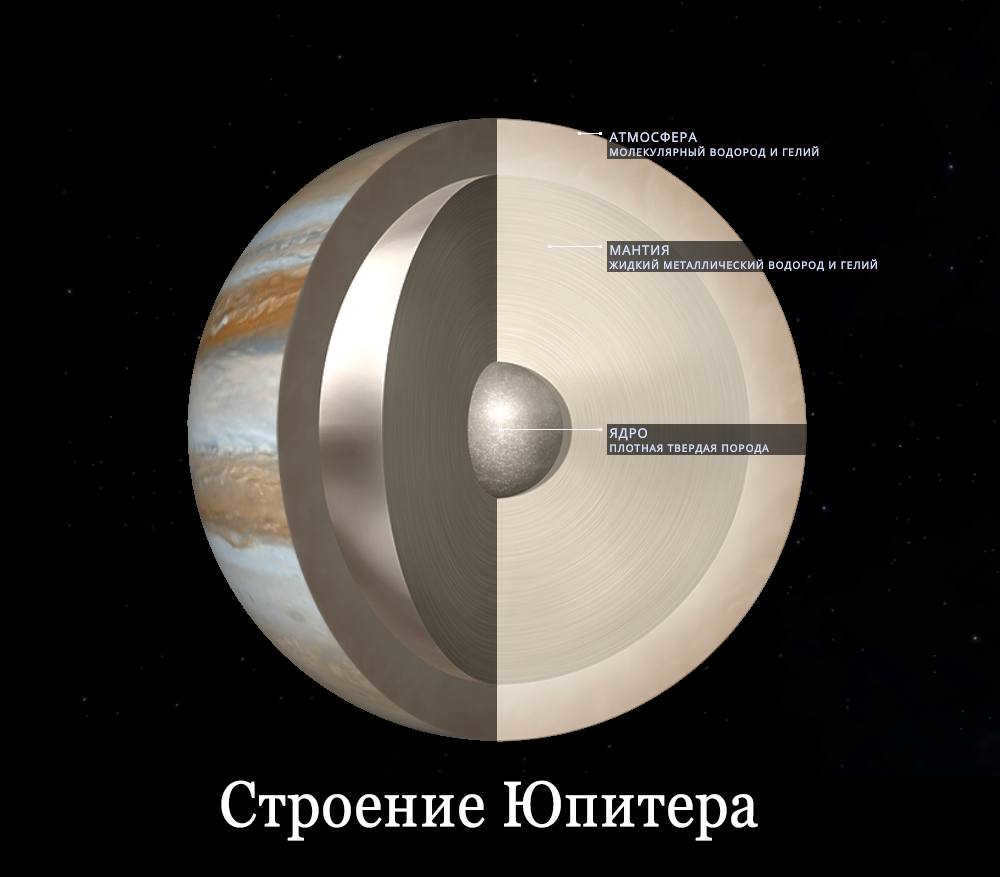
Displayed below is the “ocean” formed by metallic hydrogen. This specific arrangement of the chemical element occurs as a result of high pressures and temperatures. The concept of metallic hydrogen is purely theoretical and has yet to be produced in a laboratory setting. Scientists believe that it exists as a superfluid and superconducting liquid, capable of forming at pressures equivalent to about a million atmospheres. It is speculated that the properties of this resulting structure can potentially be maintained even after the pressure is released.
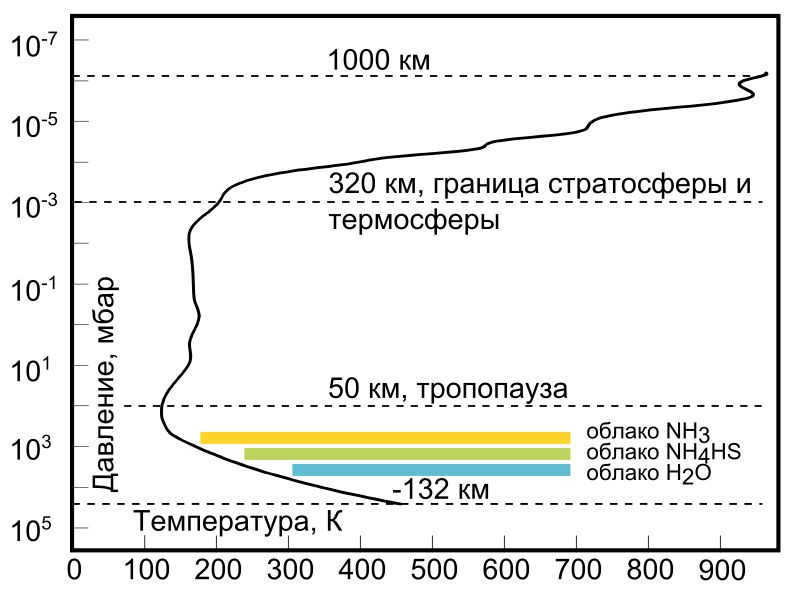

An estimated thickness of 42-46 thousand kilometers is attributed to such a layer of liquid metal on the planet. The possibility of liquid helium being present within it cannot be ruled out. While there is no distinct boundary between the atmosphere and the layer of metallic hydrogen, there exists a turbulent zone with a thickness of 7-25 thousand kilometers where a change in the phase state of this chemical element occurs.
The estimated size of Jupiter’s core is around 1.5 times the diameter of Earth, while its temperature and pressure can reach up to 30,000 K and 100 million atmospheres respectively. Scientists believe that the core is composed of a mixture of metals and silicates, with a mass of approximately 10-15 times that of Earth. This core plays a crucial role in providing heat for the processes occurring in the upper layers of the planet, thanks to the Kelvin-Helmholtz mechanism. The energy accumulated during compression is released, fueling the activities in the upper layers.
Jupiter’s atmosphere rotates as well.
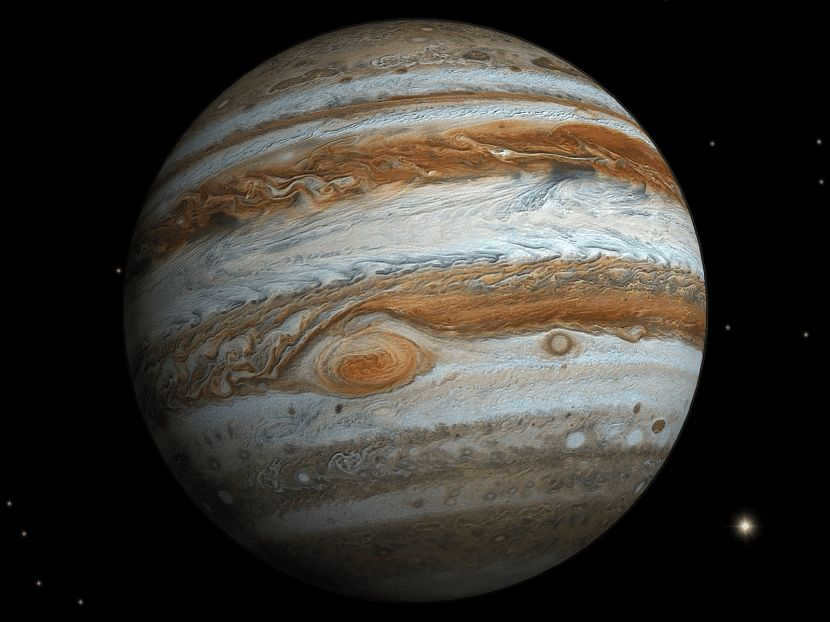
In previous articles, we have discussed various aspects of the solar system. Today, our focus will be on the majestic planet Jupiter. Jupiter is not only the fifth largest planet in our solar system, but also the largest one. In ancient Roman mythology, it was revered as the ruler of gods. To put its enormity into perspective, Jupiter is approximately 1,400 times larger than Earth in terms of size. However, due to its predominantly gaseous composition, its mass is only about 318 times that of Earth.
Are you eager to uncover all the intriguing details about Jupiter? In this article, we will delve into its mysteries and provide you with a comprehensive understanding. Simply continue reading 🙂
Distinctive Traits of Jupiter
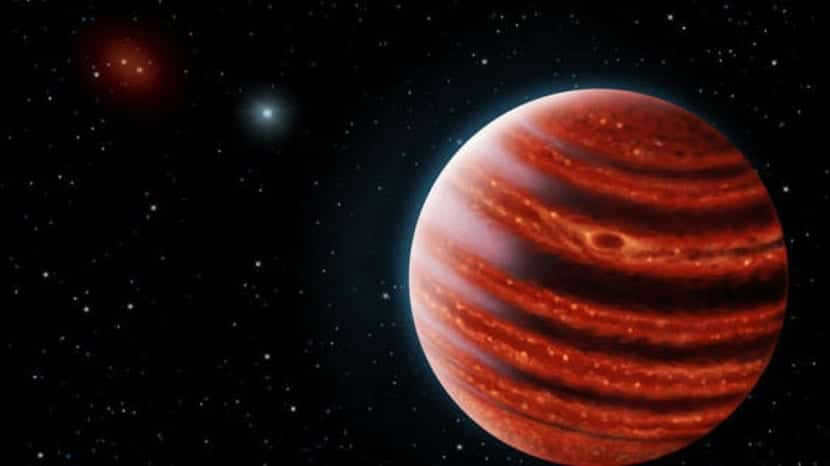
Jupiter consists mainly of hydrogen, helium, and argon gases, making its density only a quarter of that of Earth. Unlike our planet, Jupiter lacks a clear distinction between its surface and atmosphere, as the atmospheric gases gradually transform into liquids.
Due to intense compression, hydrogen in Jupiter exists in a metallic liquid state, a phenomenon not observed on Earth. The composition of Jupiter’s core remains unknown, as studying its interior poses great challenges and distances. However, it is speculated that the core is composed of icy rocky materials, owing to the extremely low temperatures present.
The distance between the two planets was a minimum of 590 million kilometers in the year 2013. However, it is possible for these planets to be located at a maximum distance of 676 million kilometers.
Characteristics of the Atmosphere and Dynamics
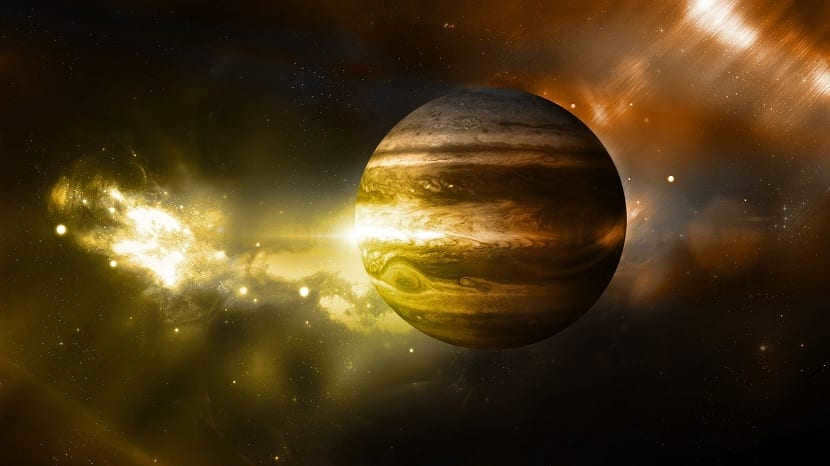

Jupiter has a diameter of 142,800 kilometers at its equator. It completes one full rotation around its axis in just under 10 hours. This rapid rotation, combined with its high concentration of hydrogen and helium, leads to the bulging of its equator. This phenomenon is observable through a telescope. Similarly, the Sun also exhibits non-uniform rotation.
Jupiter’s atmosphere is incredibly deep, stretching from the inside to the outside of the entire planet. It shares similarities with the Sun, as it is composed primarily of hydrogen and helium, along with trace amounts of methane, ammonia, water vapor, and other compounds. As we venture deeper into Jupiter, the immense pressure causes hydrogen atoms to break apart and release their electrons, resulting in the formation of atoms consisting solely of protons.
This unique state of hydrogen, known as metallic hydrogen, possesses properties akin to those of an electrically conductive liquid substance.
The dynamics of Jupiter are evident in the presence of longitudinal bands of color, atmospheric clouds, and storms. The composition and appearance of these clouds can change within a matter of hours or days. The most captivating aspect of these bands is the soft, pastel hues exhibited by the clouds. This striking coloration can be observed in the renowned Jupiter’s Great Red Spot, which is perhaps the planet’s most iconic feature. The Great Red Spot is a complex storm characterized by its oval shape and a range of colors, spanning from deep brick red to delicate pink. This massive storm system rotates counterclockwise and has remained active for an extended period of time.
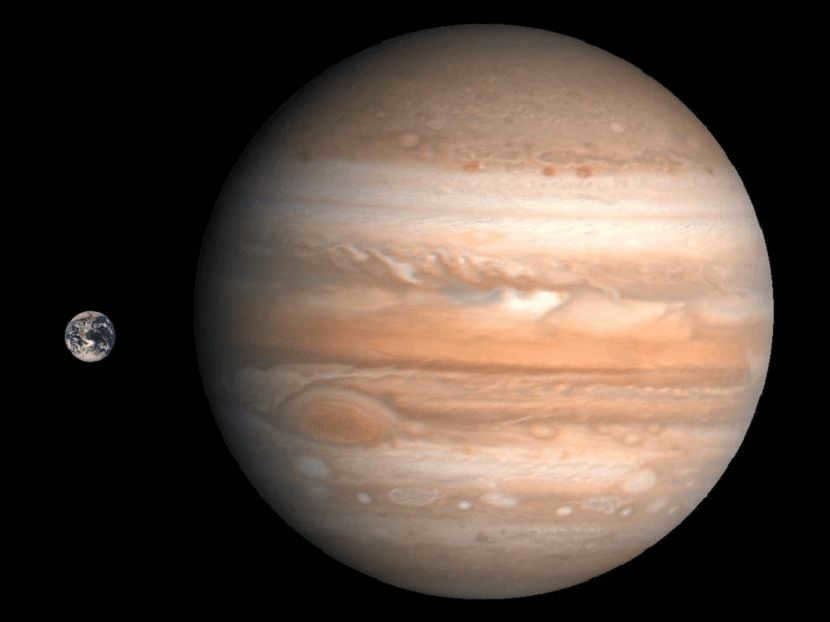
As previously mentioned, spectroscopic observations conducted from Earth have indicated that the majority of Jupiter’s atmosphere is comprised of molecular hydrogen. Infrared studies have revealed that approximately 87% of the atmosphere is made up of hydrogen, with the remaining 13% consisting of helium.
Based on the observed density, it can be inferred that the composition of the planet’s interior is also consistent with its atmospheric makeup. Jupiter, being a massive celestial body, is composed primarily of two of the lightest and most abundant elements in the universe. This composition closely resembles that of the Sun and other stars.
As a result, it is plausible to suggest that Jupiter may have formed through the direct condensation of the primary solar nebula. This nebula refers to the vast cloud of interstellar gas and dust from which our entire solar system originated.
Jupiter emits approximately twice the amount of energy that it receives from the Sun. This energy is released through the gradual gravitational contraction of the entire planet. To initiate nuclear reactions like those found in the Sun and stars, Jupiter would need to be one hundred times larger in mass. In a way, Jupiter can be considered a faint Sun.
The atmosphere of Jupiter is turbulent, with various types of clouds. The temperature is extremely cold. Changes in temperature in the upper atmosphere of Jupiter occur periodically, revealing a pattern of shifting winds similar to those observed in the equatorial region of Earth’s stratosphere. While only the outer portion of Jupiter can be studied with full clarity, calculations indicate that temperature and pressure increase as we delve further into the planet’s interior. It is hypothesized that the core of the planet may be similar to that of Earth.
At the innermost depths, a magnetic field forms within Jupiter. On the surface, this magnetic field is approximately 14 times stronger than that of Earth. Nevertheless, its polarity differs from that of our planet. If we were to use a compass, it would point south to north. As a result of this magnetic field, extensive belts of radiation with trapped charged particles are formed. These particles envelop the planet at a distance of 10 million kilometers.
The top satellites of great significance
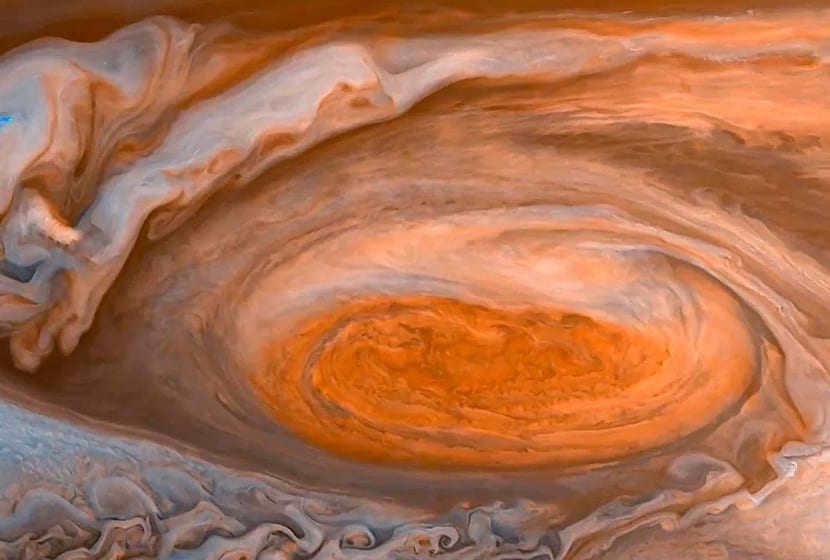
So far, scientists have discovered a total of 69 natural moons orbiting Jupiter. Recent observations have revealed that the larger moons share a similar density pattern with the rest of the solar system. The four main satellites of Jupiter are named Io, Europa, Ganymede, and Callisto. The first two are closer to the planet and have a solid, rocky composition. In contrast, Ganymede and Callisto are further away and consist primarily of ice, resulting in a lower density.
During the formation of these moons, the close proximity to Jupiter caused the less volatile particles to condense and create these rocky bodies.
By understanding these facts, we can gain a better understanding of this magnificent planet.
Full Article Summary: Network Meteorology “astronomy” Planet Jupiter
Jupiter’s atmosphere has similar physical and chemical properties to the Sun, but lacks the necessary mass for nuclear fusion reactions. Because of this, Jupiter is often called “the failed star”.
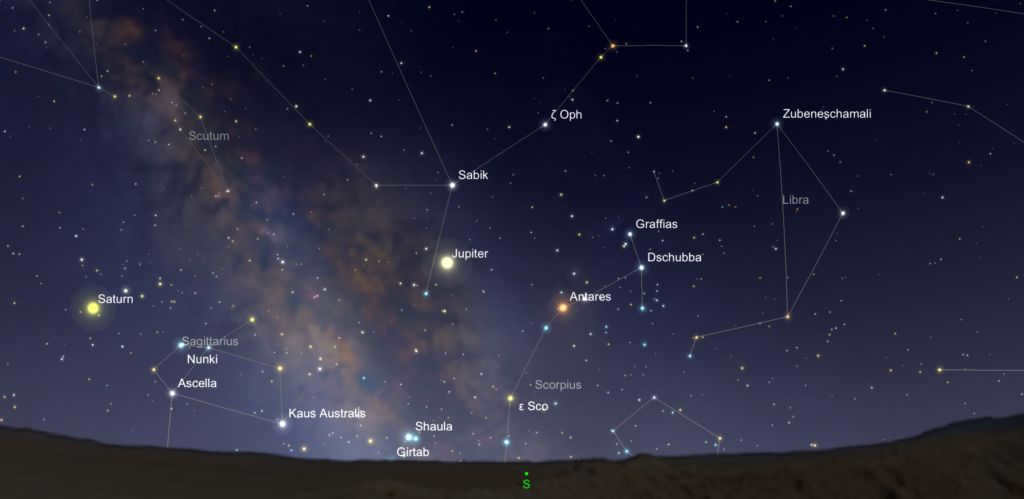
Jupiter is visible to the naked eye from Earth. It is the most luminous celestial object in this area of the heavens, and the most brilliant object in the whole nocturnal sky, with the exception of the Moon and Venus. Credit: SkyX Serious Astronomer celestial modeling.
Chemical Composition of Jupiter’s Atmosphere
The distinction between the atmosphere and solid components of Jupiter is not clearly defined, as there is no solid surface. Beneath the gaseous shell, there exists an ocean of molten hydrogen.
Composition of the Atmosphere:
- The primary element in Jupiter’s atmosphere is hydrogen, accounting for 89% of its composition.
- The second most abundant element is helium, making up 10% of the atmosphere.
- The remaining 1% consists of various elements, including:
- Ammonia
- Hydrogen sulfide
- Acetylene
- Water vapor
- Methane
- Phosphorus vapor
Jupiter itself is composed of these same compounds.
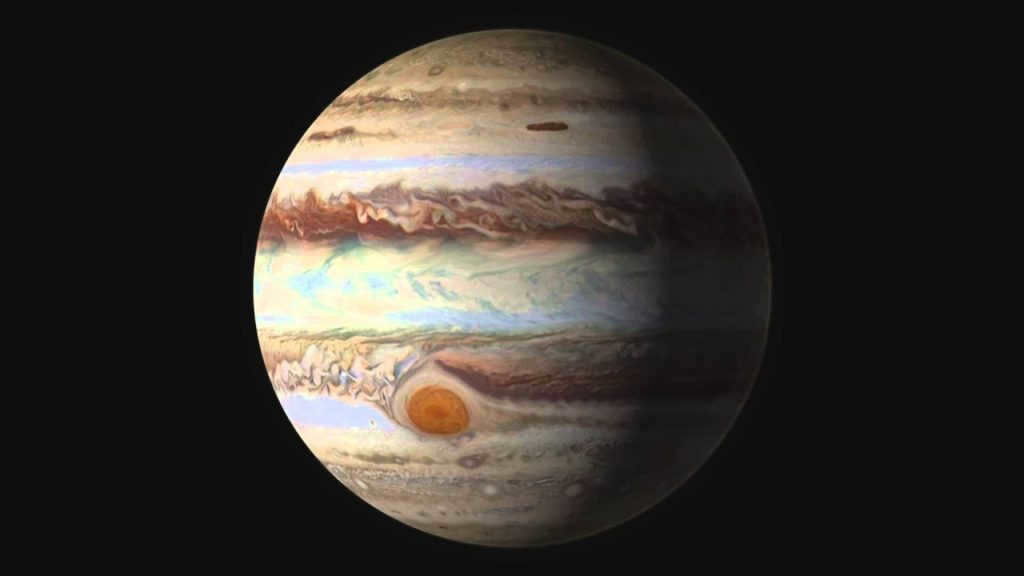

The gas giant is 2.5 times more massive than the total mass of all the planets combined or 317 times larger than Earth. Credit: Hubble Space Telescope, HST.
Atmospheric Layers
Jupiter’s atmosphere is divided into different layers:
- Troposphere.
It is located near the surface with an average pressure of 1 bar (similar to Earth at sea level) and a temperature of approximately -110°C. - Stratosphere.
It begins at 50 km. The temperature here is also extremely cold, around -100 ° C, and the atmospheric pressure gradually increases until it exceeds Earth’s pressure by 1000 times at an altitude of 300-320 km. - Thermosphere.
The layer above. As you move upwards, the temperature gradually increases and at its highest point, it reaches +725 ° C. This layer is heated by particles from the magnetosphere and also receives heat and light from the Sun. On the contrary, the pressure in this zone decreases. - Exosphere.
It begins at an altitude of approximately 1000 km above the surface and almost completely merges with the surrounding space. It has a similar structure and composition to the space it surrounds.
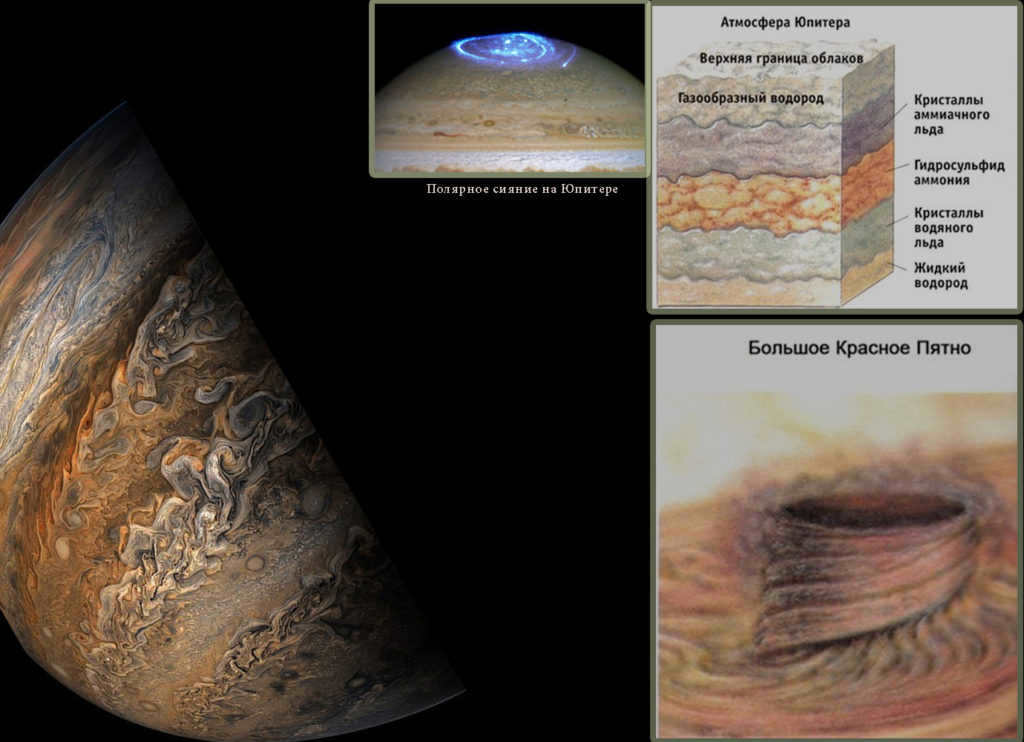
The atmospheric layers are categorized based on temperature and pressure levels. As you move higher up, the temperature readings rise and reach 725 degrees Celsius in the thermosphere, while the pressure decreases. This is the region where the stunning aurora borealis, which can be seen from Earth, appears. Credit: JunoCam, NASA.
Air mass movement
Air masses in the local atmosphere move in distinct patterns, due to two factors:
- The rapid rotation of the planet on its axis (1 revolution equals 10 hours) creates circulation belts.
- Internal heat release causes air currents to rise from the surface, resulting in zonal movement.
The circulation of air masses occurs primarily parallel to the equator. As one moves away from the equator, the direction of the flows slightly changes, turning towards the poles, and their speed slows down. While they move at a speed of 140 m/s at the equator, they gradually slow down in the middle latitudes and eventually subside to complete calm at the poles.
The zonal circulation is easily observable to onlookers due to the light hue of the streams, imparted by the frozen ammonia crystals, as well as the presence of dark clouds at the edges of the layer.
Zonal and belt flows inevitably intersect, giving rise to strong vortices at these juncture points.
The air moves uniformly and upwards, maintaining its speed and direction.
The Marvelous Crimson Spot
About 350 years ago, the exceptional European astronomer J. Cassini made a remarkable observation in the atmosphere of Jupiter. He witnessed a colossal hurricane that surpassed the size of our own planet. This extraordinary occurrence came to be known as the Marvelous Crimson Spot. This magnificent tempest features a chaotic swirling motion of air masses along its periphery, while the core of the hurricane experiences a more tranquil state.
BKP, a celestial body slightly cooler than the surrounding atmosphere, elegantly orbits Jupiter, completing one revolution in just 6 local days.
Over the course of the past century, the hurricane has undergone a substantial reduction in size, now being only half of its original magnitude. However, it still retains significant dimensions. The exact age of this fascinating phenomenon has yet to be definitively determined.
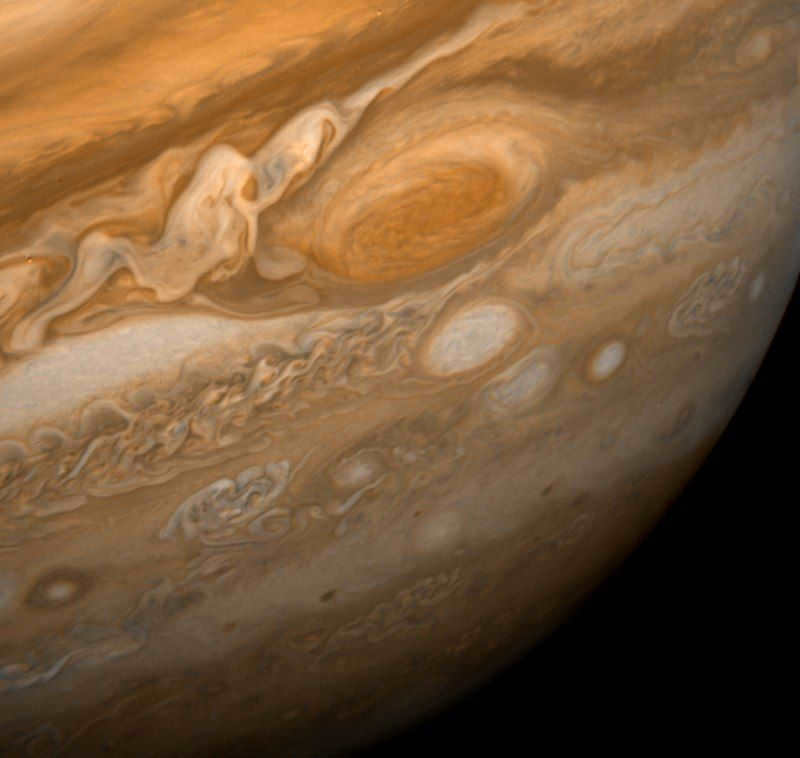
The Great Red Spot (GRS) is the biggest atmospheric vortex in the entire solar system: an ongoing high-pressure area that generates a counterclockwise storm on Jupiter. The spot fluctuates in magnitude and alters its hue throughout centuries of research. Credit: Voyager 1, NASA.
Jupiter has been explored by various space probes:
- “Pioneer”.
In the 1970s, Pioneer 10 and Pioneer 11 visited Jupiter, capturing its first close-up images and measuring its magnetic field. - “Voyager”.
Voyager-1 and Voyager-2 followed, gathering data about Jupiter’s upper atmosphere. - “Cassini.”
Cassini contributed to the detailed mapping of Jupiter by capturing the highest quality photographs of the planet to date. - “Galileo.”
The space probe Galileo orbited Jupiter for 8 years. During its mission, it accomplished the following: - It descended into the planet’s inner atmosphere;
- Explored the boundary between the atmosphere and the ocean.
- Provided fundamental information regarding the climate in the area.
- Conducted extensive chemical analyses on the air’s composition.
- Uncovered the existence of arid regions with considerably less humidity compared to the surrounding areas.
- Identified “hot spots” within thin, low-density cloud formations.
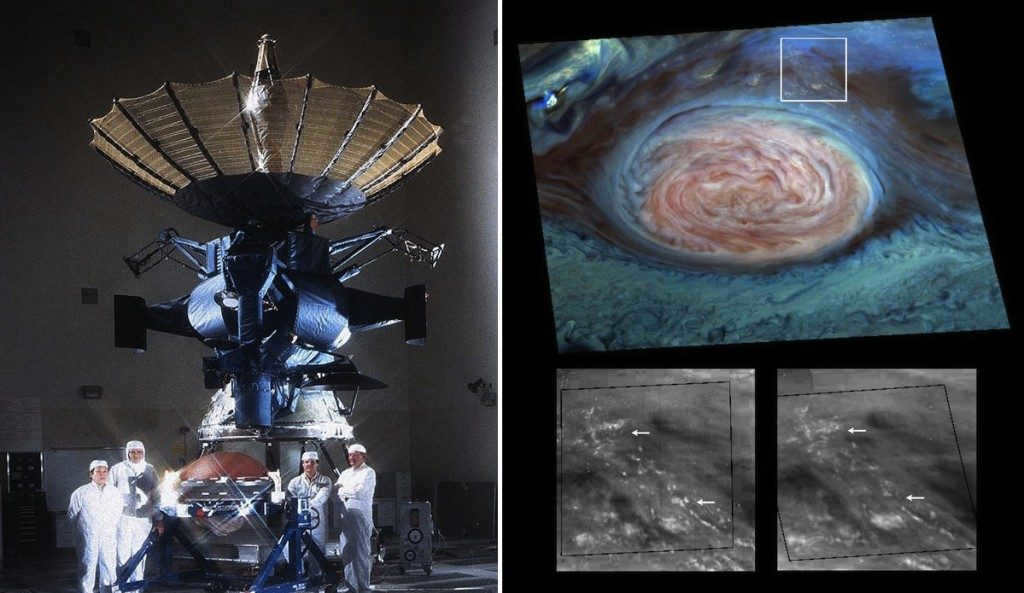
Galileo, a spacecraft developed by NASA, was specifically designed to gather data on Jupiter and its moons. Launched in 1989, it successfully entered Jupiter’s orbit in 1995 and remained operational until 2003. This mission provided scientists with invaluable information about the gas giant. Credit: Galileo Jupiter, NASA.
Fascinating Trivia and Enigmas
Jupiter is a celestial entity that has been observed since ancient times, yet many of its secrets remain unsolved.
The planet was aptly named after a prominent Roman deity, and for good reason, as Jupiter:
- possesses twice the mass of all the other planets in the solar system combined;
- rotates on its axis at a faster rate than any other celestial body;
- boasts the most potent magnetosphere imaginable;
- generates lightning bolts in its atmosphere that can extend up to 1,000 kilometers in length.
For years, scientists have been debating the potential for life to originate on Jupiter. Some argue that the planet’s conditions are conducive to the development of complex organic matter. However, the absence of water and the planet’s molten surface prevent the emergence of life forms as we know them.
Indeed, it would be unwise to ascertain the existence of Jupiter’s atmosphere, given that the entire planet is comprised of it, devoid of a solid crust. Jupiter is a massive body primarily composed of hydrogen and helium, with traces of other gases and elements. Let us explore the composition and appearance of Jupiter’s atmospheric layer.
There is a massive concentration of hydrogen (90%) in front of you. The remaining 10% consists of helium, along with trace amounts of methane, ammonia, sulfur, and water vapor. The photo illustrates the atmospheric composition of Jupiter.
The atmospheric makeup of Jupiter
As you transition from the outermost layers to the inner layers, you will experience a rise in temperature and pressure. This is why the gases are stratified into distinct layers. In the deeper regions, hydrogen undergoes a transformation into a liquid state and can even exhibit metallic properties.

The layer of the atmosphere
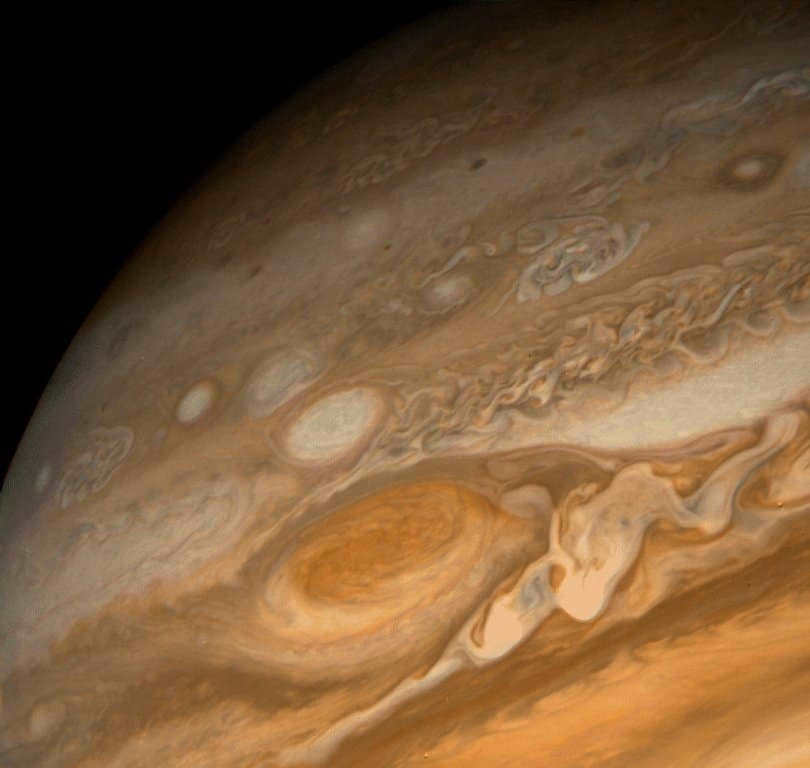

Displayed here is a detailed image of the Great Red Spot captured by the Voyager spacecraft
Scientists have determined that the atmospheric pressure at the surface is equivalent to one bar, which is equal to the pressure on Earth’s surface. Following the surface is the troposphere, which extends up to 50 kilometers. It is composed of ammonia, ammonium hydrosulfide, and water, creating distinct and eye-catching red and white bands. The white bands, known as zones, represent cooler gases that rise, while the red bands, known as belts, depict gases that fall.
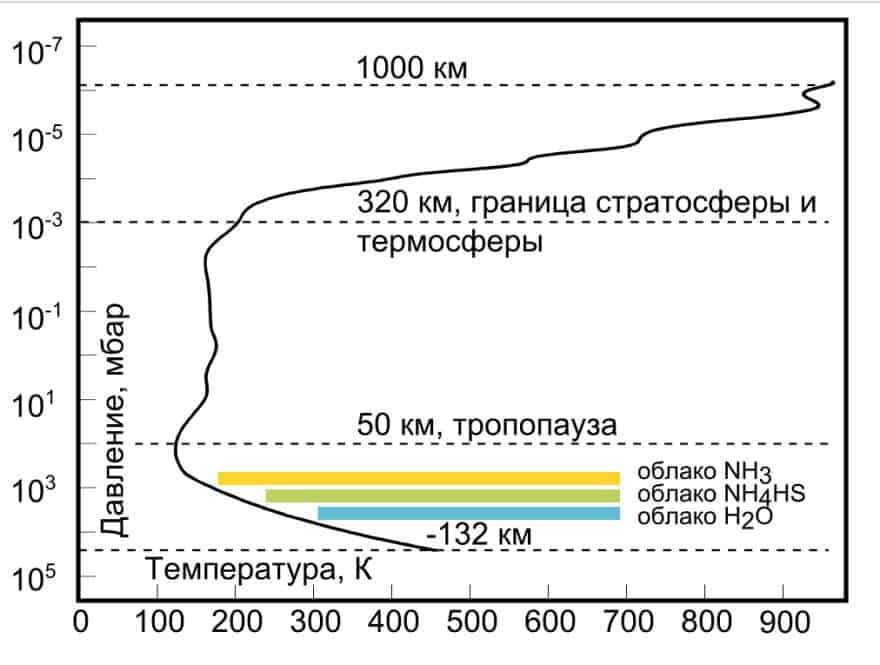
Chart displaying the correlation between atmospheric depth and pressure and temperature
Following that is the stratosphere (320 km), which contains a hydrocarbon haze. In this region, temperatures can drop as low as -100°C. The stratosphere is similar to the troposphere in that it is heated by both the sun’s rays and the planet’s internal heat. As the temperature increases, so does the velocity. This layer terminates when the pressure surpasses the Earth’s pressure by a thousandfold.
Above the stratosphere lies the thermosphere (1000 km above the surface) with a temperature of 725°C. This is where the phenomenon of the aurora borealis occurs at the poles. Furthermore, the thermosphere emits a faint glow, preventing the night sky from total darkness. This layer is heated by particles from the magnetosphere and the Sun.
A seasoned tarot reader will provide answers to the following inquiries:
What does the future hold for you? How will your relationships unfold? What is the optimal course of action?

The exosphere is located at the highest point, where gas particles spread out into cosmic space. It lacks a distinct boundary.
Jupiter’s atmosphere boasts the impressive Great Red Spot.
Jupiter’s stunning appearance is characterized by its red and white stripes. One of its most notable features is the Great Red Spot, which was first observed in the 1600s. This violent storm is positioned south of the equator and can be observed through telescopes.
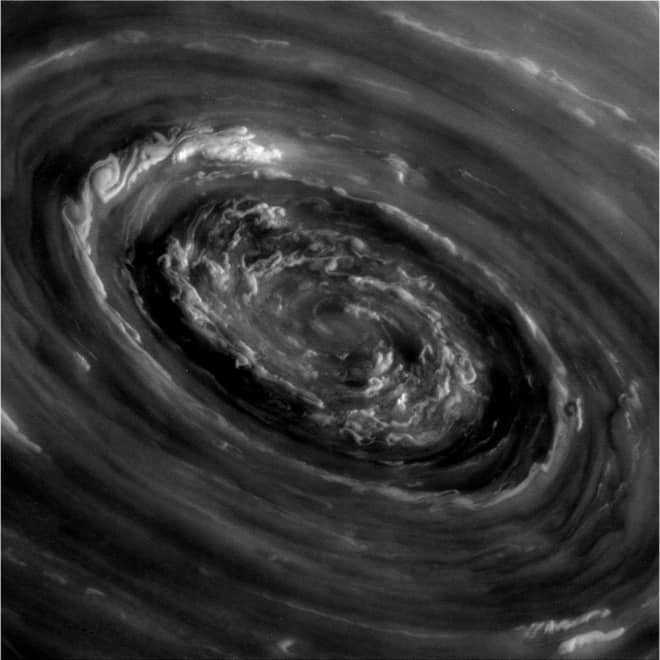

Jupiter’s well-known Big Red Spot was photographed by the Voyager spacecraft.
A massive cyclone on Jupiter has a rotation period of six days and is large enough to hold two Earths. However, recent studies indicate that it may be diminishing in size.
Due to its lower temperature compared to the surrounding band, the Great Red Spot is located higher in Jupiter’s atmosphere. The exact cause of its red hue remains unknown.
As hydrogen travels towards Jupiter, it transitions into a metallic state and generates electrical charges. These charges contribute to the planet’s strong magnetic field. Jupiter’s rapid rotation (completing one rotation in just 9.9 hours) facilitates the continuous supply of electricity to the field.

